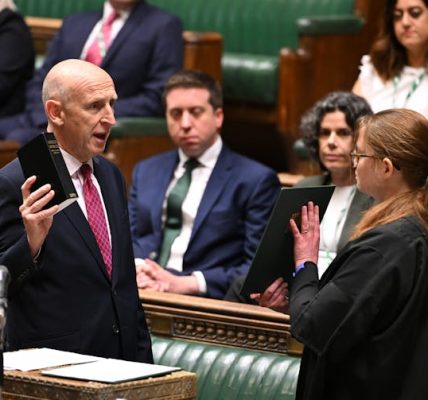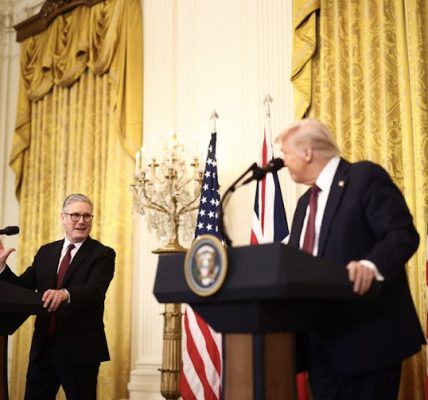From the Green party to Corbyn’s new launch – is it time Westminster took joint leaders more seriously?
Are two heads better than one? This is a question that members of the Green party will be asking themselves over the summer as they take part in the election of a new leader … or leaders.
Former co-leader Carla Denyer MP announced in May that she would not be standing again. Her co-leader, Adrian Ramsay MP, is now joined on the prospective leadership ticket by another Green MP, Ellie Chowns. (It is a Green party rule that where there is a joint leadership the job holders must be of different genders.)
Want more politics coverage from academic experts? Every week, we bring you informed analysis of developments in government and fact check the claims being made.
Sign up for our weekly politics newsletter, delivered every Friday.
They are being challenged by Zack Polanski, currently deputy leader of the party and a member of the London Assembly, who has positioned himself not merely as a solo candidate but also as a rather more radical one. While his politics have little in common with those of Reform party leader Nigel Farage, Polanksi has suggested the Greens could learn from his approach.
The contest presents us with an intriguing conundrum – or even a paradox. In the real world – that is, away from Westminster – expecting a single human being to display all the qualities and attributes required to lead a complicated business or organisation is rightly seen as unrealistic. Leadership is a team activity, to be carried out collectively.
This is one reason why it’s so troubling to see excessive pay packets being delivered to bosses who should not be taking all the credit for the success of a business.
Of course, the leadership provided by the ultimate boss matters, but good corporate governance involves testing the suggestions and instincts of the chief executive with the ideas of other senior executives or directors. This is known, perhaps rather euphemistically on occasion, as “challenge”.
But in Westminster politics a rather more traditional (we could say old-fashioned) view of leadership prevails. Here the orthodoxy holds that something called “strong leadership” stems mainly from a dominant single figure who is firmly in charge.
This belief is based in part on the mythology which surrounds the leadership of Margaret Thatcher, the “Iron Lady” who supposedly never took a step back (although she did), and who dismissed “wets” and “moaning minnies” who expressed doubt about her policy choices. Tony Blair in turn paid homage to this mythology, famously once declaring: “I’ve got no reverse gear”.
In Westminster changing your mind, even in the light of new evidence, is invariably labelled a U-turn, and is considered to be bad. This is also how the British media frames their actions.
So here is the Green party’s conundrum: against this backdrop, they would arguably get better media coverage and perhaps win more support from voters if they installed a single leader in the more conventional way. This is the case that could be made for Polanski.
But at the same time, the Greens are not meant to be just like all the other parties. They have a different view of the world, so why should they conform to the other people’s view of what leadership looks like?
Behind every strong leader
Successful businesses have often been led by double acts. Behind some swaggering CEOs there is often a cautious and competent chief financial officer making sure the numbers add up.
When the Granada media group was growing to a dominant market position in the 1990s, its CEO, Gerry Robinson, got most of the attention but his trusted managing director, Charles Allen, was an equally important, if less prominent, figure. Berkshire Hathway, one of the world’s most successful investment vehicles, has been led by the well-known Warren Buffett for decades, but for most of that time he had his old but less famous friend Charlie Munger at his side (Munger died in 2023).
Westminster’s latest prototype party, the alliance of independent pro-Gaza MPs, is also considering a joint leadership structure with former Labour MPs Zarah Sultana and Jeremy Corbyn at the helm. The difficulty here is that it is not yet clear exactly how the two figures would share their leadership duties. The much-discussed launch is planned for later this year.
Voting for the new Green party leader(s) will take place through all of August, with the result declared on September 2. We will see if the arguments in favour of a more conventional leadership structure (albeit with more radical policies and tone) prevail over the less conventional structure (but with a steadier political approach).
Either way, the Greens will continue to provide an alternative voice and approach in our still developing multiparty era. And maybe that’s a good thing too. When you look around the world at some other self-styled “strong leaders” – Trump, Putin, Netanyahu, to name but three – a break from having similar aspiring “strong leaders” at Westminster might be welcome.
Get your news from actual experts, straight to your inbox. Sign up to our daily newsletter to receive all The Conversation UK’s latest coverage of news and research, from politics and business to the arts and sciences.
Stefan Stern does not work for, consult, own shares in or receive funding from any company or organisation that would benefit from this article, and has disclosed no relevant affiliations beyond their academic appointment.


